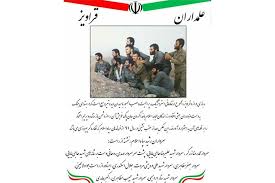Battles
Operation Bazi-Draz (Martyrs Rajai and Bahonar)
Marzieh Abedini
268 Views
Operation Bazi-Draz (Martyrs Rajai and Bahonar) began on September 11, 1981 in the Bazi-Draz Heights, on three axes with the aim of capturing heights 1000, 1150, 1100 and 1106.
After the army’s and IRGC’s successful operation in the Bazi-Draz Heights on the Sar-e-Pol-e-Zahab front in May 1981, this front came to a standstill until the heights of the region in Gilan-e-Gharb, Zaleh-Zard and Sar-e-Pol-e-Zahab were completed. An operation entitled “Operation Tabuk 6” was planned and executed on the 15th. It was implemented on August 1981. Due to intelligence problems, however, the strength and performance of the artillery ammunition, its implementation was postponed to August 31, 1981. In addition, regional operations on the one hand and the prioritization of operations in the south on the other hand, caused operations to be limited to the Sarpol-e-Aab Heights and their implementation postponed to another time.
After the explosion of the Prime Minister’s Office and the martyrdom of Mr. Rajai and Bahonar, Army and IRGC commanders, including Mohammad Boroujerdi, in order to strike at internal and external enemies who claimed that the revolution would be defeated with the martyrdom of these two, as well as the demonstration of army forces in Abuzar barracks,[HR1] which demanded the acceleration of the operation, The operation plan was approved and communicated to the operating units for implementation.
Thus, the forces of the 3rd Armored Brigade of the 81st Division of the Kermanshah Army, IRGC forces and the local Basij forces, including the Ahmad bin Musa (peace be upon him) and Kalhor Basij regiment, were deployed for this operation in Shiraz. Their mission was to attack the designated targets in the northwest, west and southwest of Gilan-e-Gharb from three fronts. They captured the heights of Koreh-Mush, Buneh-e-Dastak, Qarviz and Jagarlu Mohammad Ali in the north and west. And the Heights 1100, 1150, 1000 and 1106 in the south of the operational fronts.
Four artillery battalions were also be deployed in the area to provide support. The 6th, 7th and 8th Iraqi Armored Divisions are located in the Sar-e-Pul-Zahab and Gilan-e-Gharb regions.[1]
Just before the start of the operation, Major Badri, Commander of the 3rd Armored Brigade, assumed command of the 81st Armored Division and handed over command of the 3rd Armored Brigade to Major Zanuzi, who had previously commanded the Ahmad bin Musa Basiji unit.[2]
Operation Effendi, known as Operation Rajai and Bahonar, began at 4 am on September 11, 1981, on three fronts.
At the end of the first day of the attack, the operational units on the southern side and the Bazi Daraz Heights succeeded in capturing Height 1150.
By September 14, 1981, Iranian forces captured Heights 1150 and 1100 and part of Height 1016, and operations to capture northern Height 1100 continued.[3]
They also advanced and improved their defensive lines in the central operations center in the Shirin-Ab and Darbulut areas.[4]
After three days of suppression operations and all-out fire and about seventeen unsuccessful counterattacks by the Iraqi army with tanks and artillery fire and air support, 120 Iraqi soldiers were killed or wounded, and five tanks, an ammunition depot, about three artillery positions, and an enemy missile base in the Qaraviz area, along with four missile launchers, were destroyed by ground fire and penetration and bombs from Iranian fighter jets.[5]
In this operation, Iraq was forced to transfer the 32nd Special Forces Brigade, which had been trained and trained in Baghdad to cross the river to be used to cross the Arvand River and occupy Abadan, to this area to retake the Bazi-Draz peaks and thus carry out its implementation. This operation thwarted the possible occupation of Abadan and in the operation, carried out the operation to break the siege of Abadan.[6]
On September 17, 1981, a week after the execution of OperationsShahid Rajai and Bahonar in the Bazi-Draz Heights in the Sar-e-Pul-e-Zahab region, Iranian forces, due to the possibility of accepting dispatch areas to the new area of conflict, given the priority of finding the southern fronts, especially Abadan, for the implementation of “Operation Samen-al-Aimmeh”. They sighted Height 1150 and retreated to Heights 1153.[7]
In this operation, Haj Mohammad Ali Qaragozlu, known as Haj Mahmoud Ghafari[8], an elite observer of the western fronts, and Ali Taheri, responsible for joint observation of the army and the IRGC, were martyred on the left side of Sar-e-Pul-e-Zahab.[9]
Finally, after six days of fighting, with two hundred martyrs and 414 wounded, the Iranian forces were unable to secure the target. The number of enemies killed and wounded in this operation exceeded one thousand, and 130 were also captured. Thirteen Iraqi tanks were also destroyed.[10]
1. Izadi, Yadollah, Calendar of the Iran-Iraq War, Book 15: Breaking the Siege of Abadan, Tehran: Sacred Defense Documents and Research Center, 2017, pp. 633-636.
2. Behrouzi, Farhad, Calendar of the History of the Sacred Defense, Vol. 13: Towards the Bostan, Tehran: Islamic Revolution Documents Center, 2009, p. 311
3. Pourdarab, Saeed, Calendar of the History of the Sacred Defense, The Glory of Resistance: The Events and Events of the Year 1360, Summary of the Diary Books of the Iran-Iraq War 1359-1360, Tehran: Palak, 2017, pp. 445, 446, and 454.
4. Izadi, Yadollah, Calendar of the Iran-Iraq War, Book 15, p.722
5. Behrouzi, Farhad, Calendar of the History of the Sacred Defense, Vol. 13, p. 359.
6. Ibid., p. 394.
7. Izadi, Yadollah, Calendar of the Iran-Iraq War, Book 15, p. 789
8. Group of writers, Abuzar Barracks, Tehran: Foundation for the Preservation of Works and Publication of Sacred Defense Values, 2006, p. 26.
9. Kamerkhani, Khodadad, Abuzar, Fortress of Endurance and Sacrifice: A Narrative of the Middle Front in the Eight Years of Sacred Defense Centered on Abuzar Garrison, Tehran: AJA Political Ideological Organization, 2018, p. 90.
10. Izadi, Yadollah, Iran-Iraq War Calendar, Book 15, p. 789.
[HR1]This is an incomplete sentence. Makes no sense





